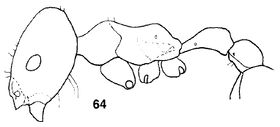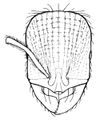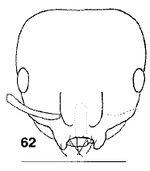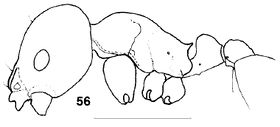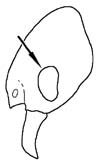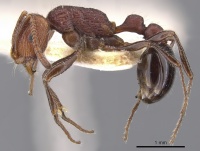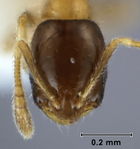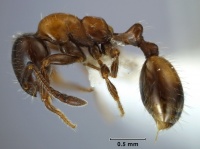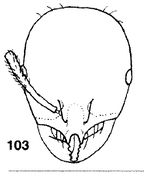Key to Australian Monomorium Species
The following key to Australian Monomorium is based on Heterick (2001)[1], Heterick (2003)[2] with additional modifications by Brian Heterick and Steve Shattuck. At the time Monomorium contained species which are now placed in Chelaner, Monomorium and Trichomyrmex. The key has been updated to include these changes.
Additional information about the species in this key can be found here: Australian Monomorium species groups
This key does not include newly described species in the M. rothsteini complex.
1
- Antenna 10-segmented => Chelaner decuria
4
- Number of mandibular teeth two (big-headed northern species with a pair of stout clypeal teeth) => Chelaner bifidus
- Number of mandibular teeth and denticles three => 11
- Number of mandibular teeth and denticles four to seven => 12
6
- Viewed in profile, eye distinctly oblique, often reaching to venter of head capsule, distance from mandible usually much less than length of eye => 9
- Viewed in profile, eye situated along longitudinal axis of head capsule, distance from mandible at most only slightly less than length of eye => 10
9
- Palp formula 2,2; head square (head width/head length = 0.91-1.02) => Monomorium eremophilum
- Palp formula 1,2; head rectangular (head width/head length = 0.78-0.90) => Monomorium nanum
10
- Propodeum distinctly cuboidal, or with metapleural lobes lamellate and extending to or near propodeum; propodeal and mesopleural sculpture often shagreenate-punctate => 13
- Propodeum more or less rounded, with small, inconspicuous metapleural lobes; propodeal and mesopleural sculpture never shagreenate-punctate, usually absent, if present confined to a few striae, particularly around the katepisternum => 14
11
- Petiolar node elongate and barrel-shaped => Chelaner capito
- Petiolar node cuneate or tumular => 15
12
- Mandible with three large teeth (one apical, two subapical) and four minute denticles; petiole with a large, ventrally carinate subpetiolar process, which projects as a spur anteriad => Chelaner sublamellatus
- Maximum number of mandibular teeth and denticles six; petiole with, at most, a vestigial carinae on its ventral surface, or small anteroventral process which projects as a spur => 16
13
- Propodeum strongly laterally compressed with diagonal impression from metanotal groove to bulla of metapleural gland, dorsal and lateral surfaces of propodeum separated by carina along entire length, dorsal face of propodeum attenuated anteriad; dark brown with yellow legs (northern species) => Monomorium carinatum
- Propodeum not as above: colour variable => 17
14
- Eye large and reniform, with posterior margin of eye emarginated => Monomorium castaneum
- Eye moderate or large, elliptical => 18
15
- Petiolar node cuneate; anterior clypeal margin broadly and shallowly emarginate with median clypeal carinae produced, at most, as pair of blunt denticles; metanotal groove present as distinct and deeply impressed trough between promesonotum and propodeum => Monomorium rothsteini
- Petiolar node tumular and inclined anteriad; anterior clypeal margin emarginate with median carinae produced apically as pair of pronounced teeth (known from one locality in central NSW) => Chelaner falcatus
16
- Eye circular, subcircular, elliptical or ovoid; head width usually > 0.55 mm; colour variable => 19
- Eye elongate or reniform, much longer than wide; head width < 0.55 mm; brown or dark brown species => 20
17
- Smooth and shining with only vestigial striae; mandible with three distinct teeth; eye rather small (approx. width of antennal scape); propodeum with declivitous face long and oblique, carinate at sides and sometimes with small lamellae at propodeal angle; anterior clypeal margin rounded; long erect and suberect setae absent from trunk; colour tawny => Monomorium arenarium
- Propodeum shagreenate or otherwise sculptured; mandible typically with four teeth and denticles; clypeus usually distinctly bicarinate, clypeal carinae often produced as small denticles. If anterior clypeal margin rounded, then eye large; colour variable => 21
18
- Erect and suberect setae absent from head and mesosoma => 22
- Erect and suberect setae present on head and mesosoma => 23
19
- Petiolar node long and low, barrel-shaped (southwestern WA) => 24
- Petiolar node variable, usually cuboidal, conical, cuneate or tumular, but not as above => 25
20
- Eye elongate, reaching almost to mandible; mesosoma, propodeum and petiole strongly microreticulate; pilosity on promesonotum and propodeum consisting of dense, short setae; colour uniform dark brown => Chelaner anthracinus
- Eye reniform; microreticulation on body surface less marked and confined to katepisternum and propodeum, otherwise smooth and shining; pilosity consisting of sparse erect and suberect setae; colour brown or tawny orange with dark brown gaster => Monomorium megalops
21
- Yellow species with erect and suberect setae on head and mesosoma; propodeum cuboidal; eye large => Monomorium silaceum
- Never with above combination of characters; if yellow with a cuboidal propodeum and large eye, erect and suberect setae absent from head and mesosoma => 26
22
- Eye large => Monomorium disetigerum
- Eye moderate => Monomorium sydneyense
23
- Long erect and suberect setae lacking on cephalic vertex and propodeum; promesonotum with one pair of long erect setae on humeral angles; long, erect and suberect setae occasionally present on mesosoma and frons; eye large; always yellow => Monomorium disetigerum
- Cephalic vertex, promesonotum and propodeum with multiple, long erect and suberect setae; eye usually moderate; yellow, brown or bicoloured yellow or yellow-brown and dark brown => 27
24
- Head capsule trapezoidal in full face view, narrowest at vertex; frons longitudinally striate with combination of appressed setulae and erect and suberect setae; promesonotal sculpture in form of microreticulation, striolae and striae on mesopleuron, and striolae on posterodorsal surface; head orange, mesosoma, petiole and postpetiole dark brown to black, gaster bright yellow, legs brown => Chelaner flavoniger
- Head capsule rectangular in full face view; frons longitudinally striate and reticulate with combination of incurved decumbent and subdecumbent setulae and erect and suberect setae; promesonotal sculpture in form of microreticulation and rugosity over entire promesonotum; otherwise coloured (usually a combination of a tawny or red head and mesosoma with some brown infuscation, and dark brown or black gaster) => Chelaner longinodis
25
- Petiolar peduncle elongate and very thin, tapering towards its articulation with propodeum; palp formula 2,2; number of teeth and mandibular denticles 4 => 28
- Petiolar peduncle not thin and tapering as above; other features variable => 29
26
- Viewed in profile, promesonotum flattened and truncated; eye generally moderate in size; erect and suberect setae rarely present on head and mesosoma => Monomorium sydneyense
- Viewed in profile, promesonotum rounded, more elongate; eye size moderate or large; erect and suberect present or absent on head and mesosoma => 30
27
- Head, mesosoma and waist segments bright yellow, gaster shining dark brown, often iridescent in some lights (introduced; NE Qld) => near Monomorium intrudens
- Colour not as above; either concolorous yellow or brown, or with both head and gaster darker than mesosoma, or tawny yellow with light brown gaster => 31
28
- Viewed in profile, postpetiole elliptical or cuboidal and rounded above => Chelaner shattucki
- Viewed in profile, postpetiole without node and attenuated anteriad, much longer than high => Chelaner petiolatus
29
- Very small (length of head, mesosoma, petiole and postpetiole less than 2 mm); elongate, smooth and shining; viewed in profile, postpetiolar node of similar size to or slightly smaller than petiolar node; dorsum of propodeum without sculpture (introduced to Australian tropics) => Monomorium floricola
- Usually larger, but if length of head, mesosoma, petiole and postpetiole less than 2 mm, either dorsum of propodeum sculptured, or postpetiole much shorter than petiole when seen in profile => 32
30
- Pale yellow; minute (length of head, mesosoma, petiole and postpetiole less than 1.15 mm); eye large => Monomorium micula
- Dark brown or russet species (head and gaster often darker than mesosoma), never pale yellow; generally larger (length of head, mesosoma, petiole and postpetiole 1.05-1.55 mm); eye size large or moderate => 33
31
- Brown to dark brown; propodeum usually relatively short and smoothly rounded => Monomorium fieldi
- Almost invariably yellow; propodeum usually relatively elongate (only known brown specimens, from Mt Cook, NE Qld, have typical long propodeum of laeve) => 34
32
- Anteromedian margin of clypeus a broadly U-shaped cleft between the median clypeal carinae that are often produced as teeth, denticles or lobes (includes arid and semi-arid graminivores, e.g. polymorphic species with disproportionately large, square heads in major caste; generally mat in appearance with rugose mesosoma) => 35
- Anteromedian margin of clypeus either convex and protuberant, straight, slightly emarginate, or shallow V-shaped groove; at most, median clypeal carinae (if present) produced as weak lobes or denticles (includes mainly wet sclerophyll and rainforest species, often smooth and shining in appearance) => 36
33
- Eye large, reniform => Monomorium stictonotum
- Eye moderate, elliptical => Monomorium aithoderum
34
- Petiolar node conical; postpetiole small and rounded; propodeal spiracle small to moderate in size (mainland Australia) => Monomorium laeve
- Petiolar node and postpetiole cuneate in profile, broadly flattened in full-face view; propodeal spiracle usually large and conspicuous (Kimberley region and NT only) => Monomorium anderseni
35
- Median portion of clypeus protuberant, clypeal carinae produced as two spinose, parallel teeth (Mt Tozer, north Qld) => Chelaner draculai
- Conformation of clypeus not as above => 37
36
- Propodeum with two sharp spines, directed upward at angle of 45° => Chelaner sculpturatus
- Propodeum with at most a pair of short denticles => 38
37
- Anteroventral postpetiolar process conspicuous as large, obliquely projecting lip; petiolar node strongly inclined posteriad, posterior face of node much shorter than anterior face; mesosoma in profile forming an almost uninterrupted arc from cervical sclerite to metapleural lobe (northern Australia) => Chelaner insolescens
- Anteroventral postpetiolar process visible, but usually small; posterior face of petiolar node about same length as anterior face or only slightly shorter; mesosoma not as above, metanotal groove often deeply impressed => 39
38
- Viewed in profile, postpetiole a curved, horizontal cone, narrowest at its junction with petiole and widest at or near its junction with gaster => 40
- Viewed in profile, postpetiole strongly constricted both anteriad and posteriad, so that its greatest diameter is at its midpoint; postpetiolar shape round or square or round with slight dorsal lip facing posteriad => 41
39
- Petiolar node cuboidal or nearly so, about as high as wide; postpetiole cuboidal or rounded in outline => 42
- Petiolar node conical, cuneate, or tumular, usually tapered dorsally, but in profile always higher than wide; postpetiole rounded or slightly elongate => 43
40
- Pilosity on head, mesosoma, petiole and postpetiole consisting of abundant, curved decumbent and subdecumbent setae and setulae; basal tooth usually enlarged, larger than other subapical teeth; peduncle of petiole thick; petiolar node low and conical => Chelaner crinitus
- Pilosity on head, mesosoma, petiole and postpetiole more sparse; basal tooth not enlarged; peduncle of petiole often thin; petiolar node larger, often cuneate or tumular => 44
41
- Palp formula 1,2; small (length of head, mesosoma, petiole and postpetiole 1.25-1.75 mm); four mandibular teeth and denticles; frons of head capsule and petiolar node unsculptured, smooth and shining => Monomorium sordidum
- Palp formula 2,2 or 2,3; size often larger, if small with four mandibular teeth and denticles, head and petiolar node distinctly sculptured => 45
42
- Propodeum armed with small denticles (reddish-orange species, semi-arid woodland) => Chelaner longiceps
- Propodeum unarmed => 46
43
- Smooth and shining rainforest species; sculpture confined to mesopleuron and sides of propodeum; most specimens with five mandibular teeth and denticles; occasionally four => 47
- Arid and semi-arid species of matte appearance; head, mesosoma, petiole and post-petiole strongly sculptured; C. longiceps usually with five teeth and denticles, remaining species always with four stout mandibular teeth => 48
44
- Palp formula 2,2; frontal lobes closely approximated so that median portion of clypeus between them is less than greatest width of antennal scape; median clypeal carinae variable; often distinctly bicarinate so anteromedian clypeal border is slightly emarginate or shallow V-shaped groove => Chelaner tambourinensis
- Palp formula 2,3; median portion of clypeus between frontal lobes slightly greater than greatest width of antennal scape; median clypeal carina a series of indistinct ridges, anteromedian clypeal margin usually elliptical and projecting well beyond lateral clypeal margins => Chelaner kiliani
45
- Postpetiole circular and massive, twice size of petiolar node; frons and promesonotum foveate (yellow-and-reddish-orange species known from two localities in SA) => Chelaner macarthuri
- Postpetiole only as large as or smaller than petiolar node => 49
46
- Smooth and shining in appearance, with sculpture confined to mesopleuron and propodeum => 50
- Usually sculptured and mat in appearance; if shining, then head capsule and promesonotum foveate and striolate => 51
47
- Median clypeal carinae often a series of ridges, not produced beyond lateral margins of clypeus => Chelaner rubriceps
- Clypeus bicarinate, median clypeal carinae produced as stout denticles => Chelaner parantarcticus
48
- Frons densely foveate and microreticulate; propodeal declivity strongly delimited anteriad by bevelled surface with well-defined anterior border => Chelaner elegantulus
- Frons not foveate, propodeal declivity not as above => 52
49
- Dorsum of head and entire mesosoma finely reticulatepunctate => 53
- Sculpture not as above, species generally smooth => 54
50
- Head, promesonotum, gaster and appendages dark brown, propodeum, petiole and postpetiole crimson; median clypeal carinae a series of ridges and not produced beyond lateral margin of clypeus => Chelaner gilberti
- Body uniformly brick-red, legs tan, gaster with a pale, transverse brown band at junction of first and second gastral tergites; median clypeal carinae produced as stout denticles => Chelaner parantarcticus
51
- Frons and mesosoma shining and polished in appearance with scattered foveae and striolae; distinct lateral striae present on propodeum; median clypeal carinae raised and distinct, produced as blunt lobes; petiolar node rugose (SA and WA: only known specimens from Clare Valley and north of Kellerberrin) => Chelaner xantheklemma
- Frons and mesosoma mat in appearance, with promesonotum, propodeum and petiole either rugose or granulose-reticulate; clypeal carinae developed as stout, incurved denticles or teeth => 55
52
- Head, mesosoma and gaster covered with decumbent setulae only, erect and suberect setae lacking; small (length of head, mesosoma, petiole and postpetiole greater than 1.55 mm) (southwest WA) => Chelaner pubescens
- Erect and suberect setae always present on body; larger (length of head, mesosoma, petiole and postpetiole less than 1.55 mm) => 56
53
- Number of mandibular teeth and denticles five; mandibles subtriangular, smooth and shining; metanotal grove virtually absent; petiolar node subcuboidal => Chelaner punctulatus
- Number of mandibular teeth and denticles four; mandibles striate; metanotal groove distinctly impressed; petiolar node conical (introduced species, only found in highly disturbed, predominantly urban environments in Australia) => Monomorium pharaonis
54
- Frons densely foveate and microreticulate; propodeal declivity strongly delimited anteriad by bevelled surface with well-defined anterior border => 57
- Frons not sculptured as above (sculpture often reduced with cuticle smooth and shining); propodeal declivity not as above => 58
55
- Frons longitudinally striate; promesonotum microreticulate and rugose; red or reddish orange; posterior promesonotum, propodeum, petiole and postpetiole strongly infuscated with black => Chelaner legulus
- Frons finely granulose-microreticulate and striolate; pro-mesonotum finely granulose-microreticulate; concolorous reddish-orange, without infuscation => Chelaner bihamatus
56
- Head capsule rectangular (head width/head length = 0.76-0.84); usually five teeth and denticles, rarely four; monomorphic; colour tawny orange or red, often with some infuscation around propodeum, petiole and postpetiole, gaster orange appendages brown => Chelaner longiceps
- Head capsule square and massive (head width/head length often greater than 0.90); always with four stout teeth; monomorphic or polymorphic or displaying monophasic allometry; colour variable => 59
57
- Four mandibular teeth and denticles; mesosoma with sparse pilosity mainly of appressed setulae => Chelaner elegantulus
- Five mandibular teeth and denticles; mesosoma covered with short decumbent and subdecumbent setulae => Chelaner lacunosus
58
- Basal tooth much broader than other pre-apical teeth; distinctly polymorphic, with large headed major workers having rather small eyes => Chelaner euryodon
- Basal tooth of same size or smaller than other pre-apical teeth; worker monomorphic or exhibiting monophasic allometry => 60
59
- Monomorphic; colour predominantly orange or red => 61
- Polymorphic or displaying monophasic allometry, with considerable size range between largest and smallest workers; colour variable but black, brown, black and orange and black and red predominate => 62
60
- Frons and promesonotum with many evenly spaced short (= width of eye) erect and suberect setae => Chelaner brachythrix
- Pilosity consisting mainly of longer erect and suberect setae, setation less dense => 63
61
- Anteromedian margin of clypeus with two broad, longitudinally striate lobes; frons longitudinally striate with erect and suberect setae, setae short (= width of eye); propodeum rounded, transversely striate; crimson to orange => Chelaner striatifrons
- Median clypeal carinae produced apically as pair of pronounced teeth; frons microreticulate and striolate with erect and suberect setae; propodeum smoothly rounded or angulate in profile or armed with small denticles or flanges, but without transverse striae; crimson to reddish orange with head, gaster and appendages darker (mid-western WA only) => Chelaner majeri
62
- Smallest minor workers dissimilar in morphology and pilosity to media and major workers; major workers rather hirsute and rugose, minor workers with shorter setae and more angulate, microreticulate propodeum; typically among major and media workers head, gaster and appendages black, dark brown or brown, mesosoma, propodeum and waist segments orange to crimson; minor workers similar in colour, or uniformly brown or dark brown; median clypeal carinae produced as single pair of lobes or denticles in major and minor workers, occasionally feebly bilobate in media workers. (Possibly a complex of two or more species is represented here.) => Chelaner rufoniger
- Morphology of minor, media and major workers similar, colouration never as above in major and media workers (usually either concolorous orange, brown or black, or brown with yellow gaster); median clypeal carinae always produced as bifurcated lobes or denticles => 64
63
- Femur enlarged, often twice as thick as tibia; head width usually greater than 0.80 mm (smooth, shining, medium-sized arboreal ants in rubriceps complex; eastern Australia) => 65
- Femur not enlarged; of similar diameter to tibia or only slightly thicker; head width usually less than 0.80 mm (mainly terrestrial species in leae complex) => 66
64
- Eyes larger (width 0.21 – 0.36 mm, length 0.34 – 0.51 mm) => Chelaner whitei
- Eyes smaller (width 0.16 – 0.20 mm, length 0.23 – 0.32 mm) => Chelaner bicornis
65
- Glistening and polished in appearance, without sculpture; promesonotum flattened, with rounded margin when viewed dorsally; uniformly russet to dark brown, with amber tarsi and funiculi (NE Qld) => Chelaner albipes
- Promesonotum usually rounded; if flattened, sculpturing present on propodeum; colour very variable, but not uniformly dark brown and rarely russet => 67
66
- Distinctly bicoloured species, with head and gaster dark brown to black; promesonotum, petiole and postpetiole orange (NE Qld; arboreal rainforest species) => Chelaner nigriceps
- Usually concolorous; if bicoloured, without this pattern of colouration => 68
67
- Head narrow (head width/head length = 0.76-0.82); propodeum rounded in profile with minute striolae over much of its surface; petiolar node cuboidal; postpetiole stout, almost spherical; head reddish-orange, mesosoma, petiole and postpetiole piceous, gaster orange with one or more broad transverse brown bands, appendages brown (northern NSW only) => Chelaner burcherae
- Head broader (head width/head length = 0.86); propodeum, not sculptured as above; colour variable => 69
68
- Palp formula 2,2; mandible with four teeth and denticles, often only three visible; propodeum unarmed (introduced species in urban or otherwise disturbed habitats) => Trichomyrmex destructor
(previously Monomorium destructor)
- Palp formula 2,3; four teeth always visible; propodeum usually angulate, propodeal angles often with denticles, especially in larger workers (M. centrale, M. leae) => 70
69
- Eye large (eye width >1.5× width of antennal scape at widest point); promesonotum flattened; katepisternum and lateral surface of propodeum with a band of faintly impressed striolae; head, mesosoma, petiole, postpetiole and appendages russet, gaster dark brown, tending to black apically (known from one series from Ravenshoe, NE Qld) => Chelaner ravenshoensis
- Eye moderate (eye width <1.5× width of antennal scape at widest point), except in species from Nightcap Ra. that lack any sculpturing on mesosoma; promesonotum usually rounded profile => 71
70
- Anteromedian margin of clypeus often projecting as narrow ellipse or rectangle, sometimes slightly emarginate, but never forming a shallow groove; clypeal denticles or lobes absent; petiolar node usually cuneate or tumular, only rarely subcuboidal or cuboidal => Chelaner leae
- Anteromedian margin of clypeus forming a shallow V-shaped groove between median clypeal carinae, that are developed as denticles; petiolar node cuboidal or subcuboidal => 72
71
- Eye large (eye width >1.5× width of antennal scape at widest point); scape relatively long (scape length/head width = 0.93-0.96); promesonotum and propodeum unsculptured (known only from Nightcap Ra., northern NSW) => Chelaner nightcapensis
- Eye moderate (eye width <1.5× width of antennal scape at widest point); scape shorter (scape length/head width = 0.72-0.88); promesonotum with microreticulation and striolae on and around katepisternum; propodeum with faint microreticulation and a few striae on lower lateral surface => Chelaner rubriceps
72
- Eye moderate in size; head capsule nearly always darker than promesonotum in full-face view, but never lighter in colour; petiolar node higher than wide and tending to subcuboidal; number of mandibular teeth and denticles usually five \(minute basal denticle may occasionally be lacking) => Chelaner centralis
- Eye large; head capsule lighter coloured than promesonotum in full-face view; petiolar node low and cuboidal in shape; four mandibular teeth and denticles; (known from one locality in Western Australian wheatbelt) => Chelaner durokoppinensis
Additional Resources
References
- ↑ Heterick, B. E. (2001). Revision of the Australian ants of the genus Monomorium (Hymenoptera:Formicidae). Invertebrate Taxonomy 15:353–459.
- ↑ Heterick, B. E. (2003). Two new Australian Monomorium Mayr (Hymenoptera: Formicidae), including a highly distinctive species. Australian Journal of Entomology 42:249–253.








